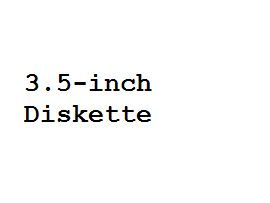The Floppy Disk was invented by Alan Shugart at IBM in 1967. The earliest floppy disks were 8 inches.
These evolved and got smaller, the first 5.25-inch disk was used in 1981. These were dubbed as
"floppy" because of the flexible plastic housing the disk. Later in the mid 1980s, improvements in
technology led to the 3.5 inch diskettes which were housed in a rigid plastic.



Parts
 The Floppy Disk is made up of a disk and the housing. The material that is used in the disk is
very similar to the material in cassette tapes. This material is a plastic disk with a coating
of iron oxide. This allows for recording information instantly, being reusable, and is fairly
inexpensive. One disadvantage of this type of material is that the data is sequintial. This means that,
like a cassette tape, there is a begining and an end with no way to skip a song. However, because it
is in a disk shape, it can spin to skip data files.
The Floppy Disk is made up of a disk and the housing. The material that is used in the disk is
very similar to the material in cassette tapes. This material is a plastic disk with a coating
of iron oxide. This allows for recording information instantly, being reusable, and is fairly
inexpensive. One disadvantage of this type of material is that the data is sequintial. This means that,
like a cassette tape, there is a begining and an end with no way to skip a song. However, because it
is in a disk shape, it can spin to skip data files.
Data Read/Write
The Drive that reads and writes the disk consists of a few major parts. The Read/Write head is
located on both sides of the disks. However, it is not directly opposite of each other so to
prevent them from touching. One head is used to read/write and the other is used to track. There
Drive Motor that spins the diskette at around 300 RPM. The Stepper Motor is what the read/write is
connected to. It is used to precisely track the revolutions of the disk.



 The Floppy Disk is made up of a disk and the housing. The material that is used in the disk is
very similar to the material in cassette tapes. This material is a plastic disk with a coating
of iron oxide. This allows for recording information instantly, being reusable, and is fairly
inexpensive. One disadvantage of this type of material is that the data is sequintial. This means that,
like a cassette tape, there is a begining and an end with no way to skip a song. However, because it
is in a disk shape, it can spin to skip data files.
The Floppy Disk is made up of a disk and the housing. The material that is used in the disk is
very similar to the material in cassette tapes. This material is a plastic disk with a coating
of iron oxide. This allows for recording information instantly, being reusable, and is fairly
inexpensive. One disadvantage of this type of material is that the data is sequintial. This means that,
like a cassette tape, there is a begining and an end with no way to skip a song. However, because it
is in a disk shape, it can spin to skip data files.